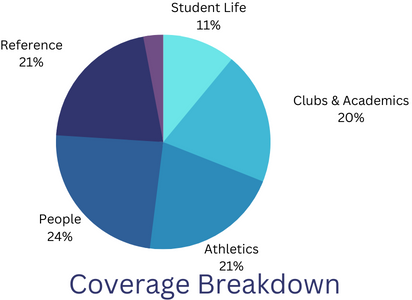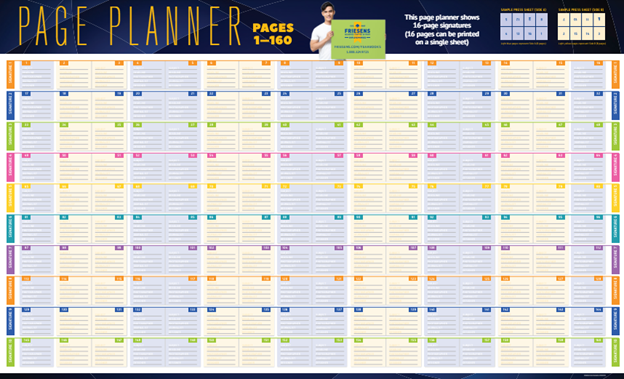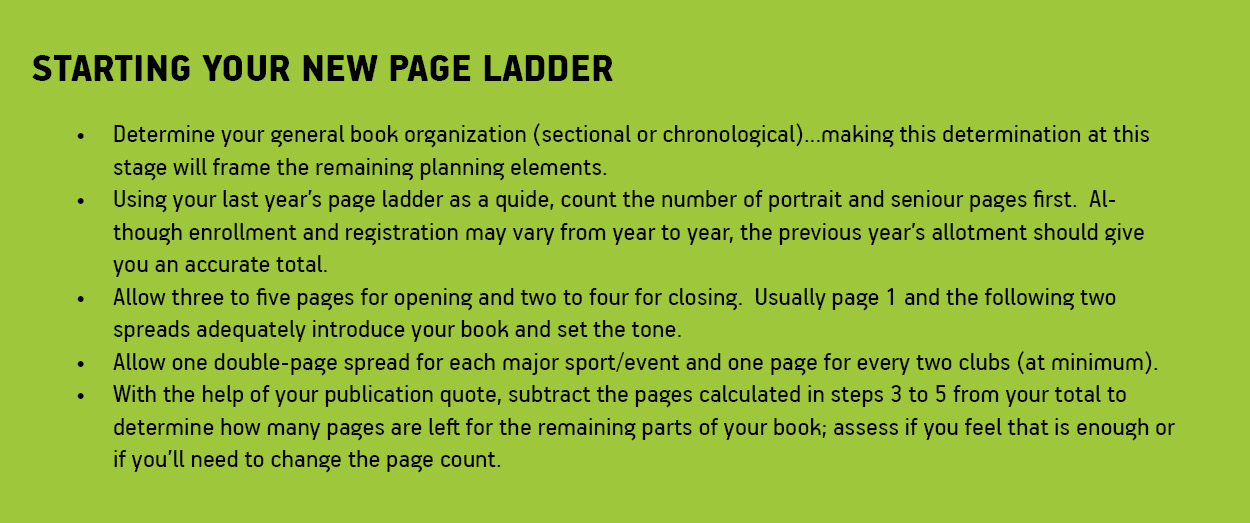- 4 Minutes to read
- DarkLight
Coverage Organization
- 4 Minutes to read
- DarkLight
Although you have already established your Yearbook’s organizational standard (Traditional vs Chronological vs Other), coverage still requires another layer of organization. We must ensure that all stories are covered, hidden story coverage is uncovered, and secondary coverage is developed.
What Does Coverage Look Like?
In a typical yearbook, you’ll want to organize your content by category or sections. The categories we see most often are Student Life, Athletics, Academics, Clubs & Organizations, and People. But what percentage of your book should go to each category or section?
• 11% of your book should cover Student Life
• 20% should cover Clubs and Academics
• 21% can go to Athletics
• 24% for People
• 21% to Reference
Adding these up you may notice it comes to 97%...you always want to leave some wiggle room!

Page Planners/Ladders
A ladder is a page-by-page topical outline of the yearbook used for planning content and giving the yearbook structure. Like a body without a skeleton, a yearbook without a ladder would collapse. It provides advisors, editors and staff members with the general structure required to stay organized and keep things on track. A sample page ladder can be found both in the Yearbook Kit (as a poster) and at the front of the “Plan It” handbook.

Most planning calendars often show big events such as big games, tournaments, events, etc. Look at creating timelines, deadlines, and submission dates for other kinds of coverage. Secondary coverage can be gathered at almost any time of year; make sure you add specific timelines on the calendar for surveys, gathering of statistics or other data you need to generate this coverage.
Make sure to indicate how you will be gathering this information (paper polls, interviews, social media polls, etc.)
For hidden story coverage, create more general deadlines (possibly monthly), where so many stories must be submitted by staff members. These stories may often require one or two meetings to gather all the facts. Giving longer deadlines will ensure you can get the entire picture and create truly meaningful coverage.
Sectional Page Ladder (Traditional)
The most typical type of page organization is to organize your pages by category. Your sports are kept together, and your clubs are all in one set of pages. This can make it easy to find coverage without looking through the index, but it can also make it hard to fill in holes when events are missed, canceled, or if you simply don’t have as much coverage as you’d planned for.
Download the Sectional Page Ladder
Chronological Page Ladder
Another option for organizing your yearbook is a chronological book. This can take several forms such as by season, month, week and even day. This sets your book up to begin in September, and end with Graduation, ensuring you won’t have empty page spaces that you’re unsure of what to do with in the middle of your book.
In the specific (and most popular) example of per season, a summer section may allocate four spreads that would include sports, activities, and academics. Sports may be included in terms of training camps; Academics could include parts of summer school; Student life might include modules on summer jobs, vacations and camps; Clubs and Organizations could include any activities that took place during orientation or student trips.
Download the Chronological Page Ladder
Ladder Depth
Generally, most yearbook page ladders only offer one layer of organization; covering the essentials. Adding different layers of coverage organization on different pages enables a staff to know what other pieces they need to gather. Consider adding in a section for each page where you indicate what secondary coverage you will be adding or an area to indicate if you will be adding in a hidden coverage story. These details will help your staff know what they should be gathering where.
Getting Started on Your Page Ladder
Before looking at creating this year’s ladder, we must first take stock what has been done and review last year’s ladder. By doing so, it allows us to refine our future ladder according to the challenges faced, changes in the school and other unexpected items. Some of the questions that should always be asked are:
• Did we have enough room for portraits last year?
• Were any activities and/or sports left out of last year’s book?
• What activities were canceled last year that may return this year?
• Do we have any new sports starting up this year?
• Did we want to keep the same general structure as last year?
• What could we cover better if we had more room?
• Did something unexpected happen over the course of last year?
• Could we use more pages in this book? Conversely, could we cut the number of pages back?
Once you have completed your review of last year’s ladder, it’s time to get started on this year’s page ladder!

Remember, the page ladder is flexible. Changes will happen, due to event changes. Have back-up spreads or at least concepts and photos for them if cancellation occurs. Be flexible. Your page ladder should be alive and flexible and something that is available for the entire staff to see.
Once you’ve completed your ladder and reviewed it with both your advisor and Print Consultant, start assigning specific deadlines to all spreads so that you and your class can have the “big picture” in focus from the start.
